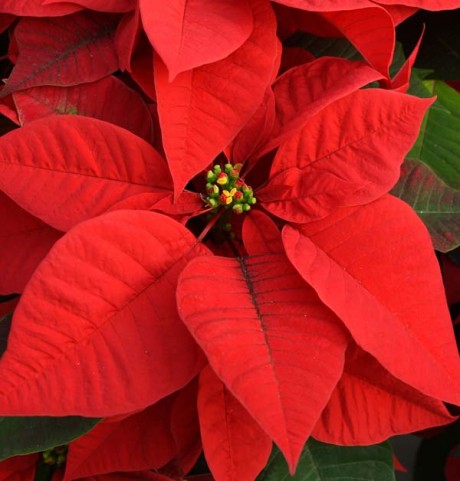Poinsettia pointers
Plus garden to do's for December & January
By L.A. JacksonPoinsettias are Christmas. These are the popular plants that always brighten up homes with Yuletide cheer. Knowing how to properly choose and care for them is important to extending their pretty displays through the Christmas season and even beyond. So, here are some helpful pointers to keep in mind:
When picking a poinsettia, the plant should, of course, look pretty, but it should also be upright with stiff limbs. Also, healthy foliage will usually be deep green, not light green. The "flowers" (actually bracts) are normally brightly colored and fairly flat.
If you buy a large poinsettia, and it comes in a light plastic container, consider moving it to a clay pot for better stability.
Remove any holiday wrapping from the pot. Such packaging will act as a water trap and turn the container into a small swamp.
At home, let the light shine on your poinsettia! Either treat it to at least six hours of sunlight a day, such as can be provided by a south-facing window, or constant exposure to bright indoor lights.
You would think these natives from Central America would love heat, but not so. Generally, a room that has daytime temperatures of about 70 degrees and hangs around the 60 to 65 degree mark at night is ideal. Also, no drafts. Poinsettias won't do well in stray breezes, hot or cold.
Water when the soil's surface is just dry to the touch. Watering every three to four days will usually do the trick. For best results, use only tap water that has been allowed to warm to room temperature.
If you want your poinsettia to still be growing and showing off after Christmas, a light fertilizing once a month using a diluted mix of water and soluble houseplant fertilizer will take care of the nutrient requirements.
Garden To Do's
December
- A good substitute for lime is wood ash, so after the ashes of a wood fire have grown cold, sprinkle a light application on garden beds that have high acidic concentrations (low pH).
- When your Christmas cactus comes into flower, keep it in bright light but reduce watering to prolong its bloom period.
- Now is a good time to take hardwood cuttings of such deciduous woodies as forsythia, Japanese quince, mock orange, spirea and viburnum.
- Consider adding accents that last year-round in the garden. Vases, statuary, fences, benches, walls, water fountains — these are constants that can help keep the garden interesting even in winter.
January
- If squirrels are invading your bulb beds, spread chicken wire as a barrier over the ground and secure (as well as hide) it with an inch or two of mulch.
- The vegetable garden doesn't have to be a barren place in the winter, as this month is a good time to plant asparagus, onions (seeds) and sugar snap peas.
- Got milk? Start saving gallon containers for use in the early spring garden. By cutting the bottoms out, they make great hot caps for tender, new plants.
- Got toilet paper? Save the cardboard tubes for use this spring as cutworm collars around susceptible young plants.
- Dry indoor heat can be tough on houseplants, so provide humidity by occasionally misting the leaves and placing the pots on trays of moistened pebbles.
-
Share this story:


